CHITO-RYU AND THE MILITARY
The data discussed below was obtained from newspaper articles, interviews where possible, documents and books. Should you have any additional data or know of others who were in the military that studied Chito-Ryu karate please contact this web site. This article is not intended to compare one person's rank to another's. Rather, it is intended to set forth the brotherhood of military personnel who studied Chito-Ryu. Research on this subject is continuing and is subject to change.
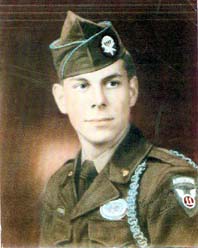
Dometrich |
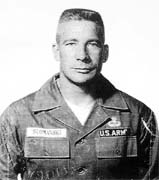
Slomanski |

Ruemann |
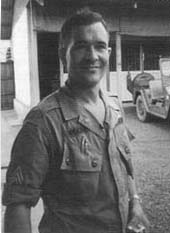
Pochinski 1967 |

Warren 1955 |
 Edwards 1955 Kumamoto |
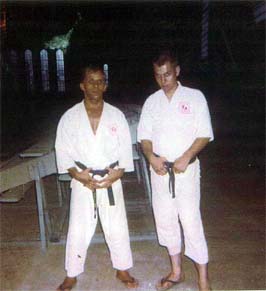
Dometrich and Warren 1963 |
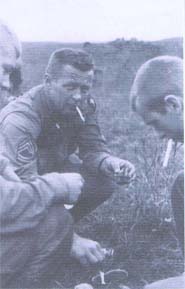
Wightman |

Elvis 1960 |
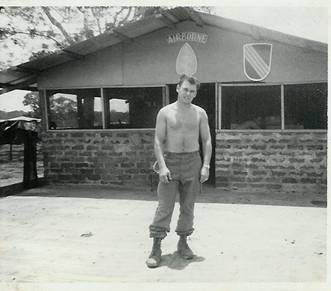
Terlikowski 1965 Bu Gia Mop |

Mike Foster |
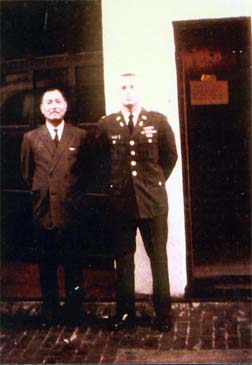
O-Sensei and Coyle - US Hombu 1967 |
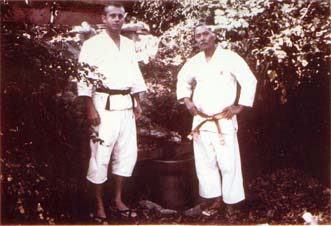
O-Sensei and Coyle 1967 Dometrich home |
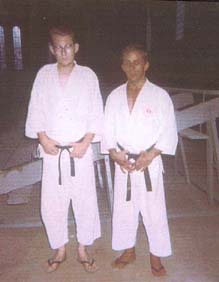
Berkshire and Warren 1963 |
William J. Dometrich Sensei began training in Chito-Ryu karate in 1953 at the Beppu, Japan police headquarters located on Mochigahama Street a few blocks North of Nagare Kawa Street, or Broadway as the GI’s called it. His teacher was Shirahama Sensei. At the time Dometrich Sensei was in the 187th Regimental Combat Team (RCT), 2nd battalion, HQ Company stationed at Camp Chickamauga. O-Sensei Chitose traveled to Beppu to conduct the classes at the police headquarters and Dometrich Sensei traveled to Kumamoto to train at O-Sensei’s dojo. Dometrich Sensei left Japan and the Army in December 1954 as a san-dan and never met the individuals discussed below while in Japan. On February 5, 1955, Dometrich Sensei began teaching Chito-Ryu in Clarksburg, West Virginia. (This web site details Dometrich Sensei’s history.)
About 1946 Henry “Hank” Slomanski began training in judo when he was stationed in Japan. The Korean War broke out in June 1950 and he was shipped out to Korea.
In 1949 Robert Wightman enlisted in the Army. He served in Korea in 1953 with the 24th Infantry Division.
Wallace Reumann began his training in Chito-Ryu about 1951 and trained in Japan for 5 1/2 years when he was stationed there.
In 1953, Wightman was wounded by grenade fragments and was the recipient of a purple heart and 3 bronze stars. After the Korean War ended in July 1953, Slomanski returned to Japan toting 3 purple hearts, a silver star and a bronze star. He requested to be transferred to the 187th, but because of injuries to his legs during the Korean War he was stationed on Kyushu handling customs, immigration and quarantine.
In 1954 Warren “Po” Pochinski, who was in the 187th RCT, 3rd Battalion, Company L, studied Chito-Ryu from a Japanese instructor at Camp Chickamauga, at the base gym, in Beppu, Japan. He does not recall the instructor’s name, but the instructor often referred to “Master Chitose.” Po’s training at the base spanned 3 months.
About 1955 Slomanski found a police station in Beppu where karate was taught and asked to join. Within 6 months, he had beaten everyone at the dojo. O-Sensei Chitose learned of Slomanski, went to the police station to watch Slomanski and invited him to Kumamoto. Slomanski put in a transfer request to transfer to the 187th Airborne stationed at Camp Wood, Kumamoto. After being transferred, Slomanski began karate training in earnest under O-Sensei Chitose’s tutelage.
Roger L. “Tony” Warren and Arby Edwards began studying karate in 1955 while stationed in Kumamoto at Camp Wood with a security unit for the Army, 508th Airborne. Edwards trained briefly with his Army buddy, but Warren trained in Chito-Ryu until his discharge. They trained directly under O-Sensei Chitose. Warren left the Army and Japan in 1956 as a san-dan.
Pochinski arrived at Ft. Campbell, Kentucky in January 1956
In August 1956, Slomanski was involved in a karate tournament in Japan where he was quite successful and earned the title “International Karate Champion.” It is reported in the April 1960 Nashville Tennessean Magazine that he defeated 126 Japanese competitors. About 1956 or 1957, before Slomanski returned to the United States, O-Sensei gave Slomanski a go dan certificate. In 1956, Wightman was at Ft. Benning where he enrolled in jump school and became a parachute instructor.
In 1957, Warren opened a Chito-Ryu dojo in Peoria, Illinois and later was promoted by O-Sensei Chitose to yon-dan.
In 1957, Reumann opened his first dojo was in New Jersey where James Cheathem was a student. On December 1, 1957, Reumann opened a dojo in Monterey, California. The school was called the American Karate Federation and was affiliated with the All Japan Karate-do Federation. In 1957, Wightman arrived at Ft. Campbell and was with the 101st Airborne.
From 1958 to about 1962 Slomanski was stationed at Ft. Campbell, Kentucky. He and Wightman were on the Ft. Campbell parachute club. In 1958, Wightman began training in karate with Slomanski.
On February 2, 1959, Joseph Virtue was responsible for organizing the Chito-Ryu karate training at Ft. Campbell, Kentucky. Virtue was a 4th dan/Shihan and was assisted by Estle Pruitt who was also a 4th dan. Pochinski signed up for the class and began a second tour training in Chito-Ryu that lasted for 3 months. Slomanski also was involved in the class, but never directly taught Pochinski. A base newspaper article states that Slomanski “holds the third highest degree belt in karate and presently is the understudy for two red belts.” The April 1960 article in the Nashville Tennessean Magazine newspaper states that the two red belts are O-Sensei Chitose and Gogen Yamaguchi and refers to Slomanski as “International Champion”. In 1959, Robert Wightman, Melvin Hill, and Alby Balinong trained in Chito-Ryu at Ft. Campbell and on April 25, 1959, Slomanski issued Wightman his sho-dan rank. On October 24, 1959, Slomanski promoted Wightman to yon dan and Wightman continued to teach at Ft. Campbell. About 1960, Melvin Sauer was a white belt. Another student named Armando Gallardo also trained at Ft. Campbell, but may have had previous Chito-Ryu training elsewhere. Dan Inosanto was in the Army and stationed at Ft. Campbell in 1959 where he began his karate training. Inosanto left the Army in 1961.
To Tell The Truth episode 139 originally aired on August 18, 1959, that featured Henry Slomanski and his cover was “International Karate Champion.” The episode is in the library at the U. S. Chito-Kai hombu.
Slomanski visited Memphis on occasion with the Army and trained Elvis Presley. On July 21, 1960, Elvis received his black belt rank from Slomanski and Elvis kept his sho-dan certification in his wallet until his death. There are several pictures available of Elvis sporting a Chito-Ryu lapel pin during the late 1960-1961 era.
In 1961, Fred Coyle was stationed in Europe and he began studying Chito-Ryu in 1961. His sensei was Robert Wightman who was assisted by Gallardo who achieved the rank of brown belt. Pochinski and Balinong joined the karate club and continued their training. William Ferguson also trained in Germany under Wightman as did Pedro Vasquez who was stationed at Lee Barracks in Mainz/Gonsenheim, Germany. Shortly thereafter, Vasquez was transferred to Ft. Campbell, Kentucky where he trained with Slomanski, Virtue and Pruitt.
In early 1963 Richard Terlikowski transferred to Ft. Bragg and began his Chito-ryu training under Virtue. Slomanski visited the classes on a few occasions.
On March 20, 1963, the 8th Infantry karate team participated in the International Invitation Karate Tournament held in Sembach, Germany. The karate team consisted of Coyle, Pochinski, Balinong and Ferguson and the team won the tournament. Pochinski won first place overall.
On October 17, 1963, Slomanski bestowed on Elvis his ni-dan rank.
In 1963, Melvin Sauer was at Ft. Benning where he taught Chito-Ryu because about August 20, 1963, John Burkhardt started training at Ft. Benning. On November 25, 1963, Sauer, promoted Burkhardt to brown belt. Sauer included his title of "4th degree black belt, Shihan (Insructor)" on Burkhardt's certificate. Burkhardt trained with Gervis Cherry, Gabe and Abe Navaro, Will Smith and civilian O.P. Carlisle. Burkhardt and Cherry were close, personal friends. Burkhardt left the Army in 1965, but stayed in contact with Slomanski. Burkhardt received his yon-dan certificate from Slomanski on December 2, 1965, and began teaching civilians.
On July 1, 1964, O-Sensei Chitose certified Pochinski's yon-dan rank. O-Sensei Chitose certified Coyle’s sho-dan rank on August 10, 1964. On August 20, 1964, Virtue issued Terlikowski his sho-dan rank that was later certified by Slomanski on December 3, 1964. On November 1, 1964, O-Sensei Chitose awarded the title of Shihan to Reumann. On March 20, 1965, O-Sensei Chitose awarded Reumann his go-dan rank in Chito-Ryu.
About July 1965, Wightman was in Vietnam with the B 2/501st Infantry, 101st Airborne Division. Wightman is described in a book as being one of the greatest combat leaders in the Army. Lieutenant General Henry “Hank” Emerson is quoted as saying: “The Army was fortunate enough to have him [Wightman] among its ranks.” Emerson pushed and obtained permission to issue Wightman a battlefield commission, but Wightman declined stating that he would rather be good enlisted man than a lousy officer. See About Face, Colonel David H. Hackworth and Julie Sherman, Simon & Schuster, 1989, p. 472.
Terlikowski was also in Vietnam in the summer of 1965 where he met Ferguson and they practiced Chito-ryu together. Ferguson informed Terlikowski of the training in Germany and said that Pochinski "had educated feet."
Coyle received his san-dan rank from O-Sensei Chitose on September 11, 1967. In the late 1960’s, Coyle was stationed in Tallahassee, Florida and taught the Florida State University karate team. After FSU, in the late 1960’s Coyle was assigned to train servicemen in hand-to-hand combat and stopped training specifically in Chito-Ryu karate. However, his instruction to servicemen included many Chito-Ryu concepts. Coyle met O-Sensei Chitose in 1967 at William Dometrich’s home.
Although Reumann never joined, his application dated December 6, 1968, to the United States Chito-kai indicates that his Chito-Ryu instructors while in Japan were Senseis Fukamoto and Slomanski, 6th dan, and he trained in Kokura City, Japan.
Mike Foster studied Chito-Ryu karate when he was stationed in Japan in the late 1960’s with the Air Force. Foster became a very good tournament kumite competitor.
About the 1970’s Warren closed his Chito-Ryu dojo and his student Dave Berkshier opened his own dojo and taught Chito-Ryu. Berkshier no longer trains or teaches karate and the dojo disbanded.
From 1969 to 1972 Pochinski was stationed at Ft. Bragg with Special Forces where he taught Chito-Ryu. In 1972, Pochinski was stationed in Panama Canal Zone and began studying Tae Kwon Do. In 1977 he was in Utah training the Utah National Guard hand-to-hand combat that included Chito-Ryu principles and Tae Kwon Do.
Slomanski died on April 23, 2000, from a bout with a long illness. Wightman passed in November 1999. It is believed that Reumann is deceased. Ferguson gave the ultimate sacrifice and was a Vietnam casualty in 1967. He was posthumously awarded the Distinguished Service Cross, our nation's second highest award for valor.
Special thanks to Slomanski’s widow, Coyle, Pochinski, Warren, and Edwards who provided their recollection of events and some of the pictures. Slomanski is correctly spelled in this article and he was not a Vietnam War casualty as many report which is why his name is not on the Vietnam War Memorial. Slomanski’s obituary is in the April 26, 2000, Richmond Times Dispatch.
written by:
Don Schmidt
U.S. Chito-ryu Karate-do Federation
Hombu Dojo
More Photos below courtesy of Warren Pochinski:
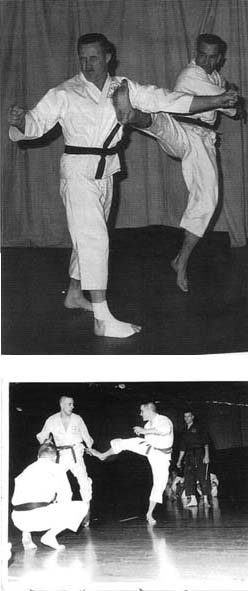 |
Pochinski and Wightman Pochinski and Ferguson with Reumann in Background and Wightman in the foreground 1963. |
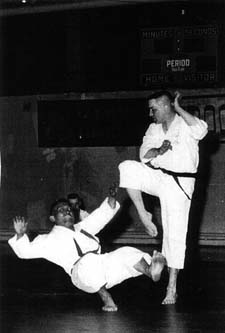
Balinong and Pochinski |

Pochinski Ft. Bragg 1969 |
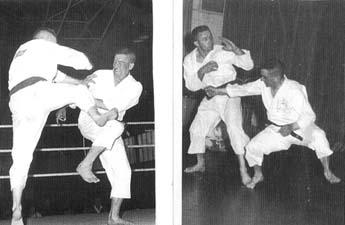 |
| Worley and Pochinski Wightman and Pochinski |